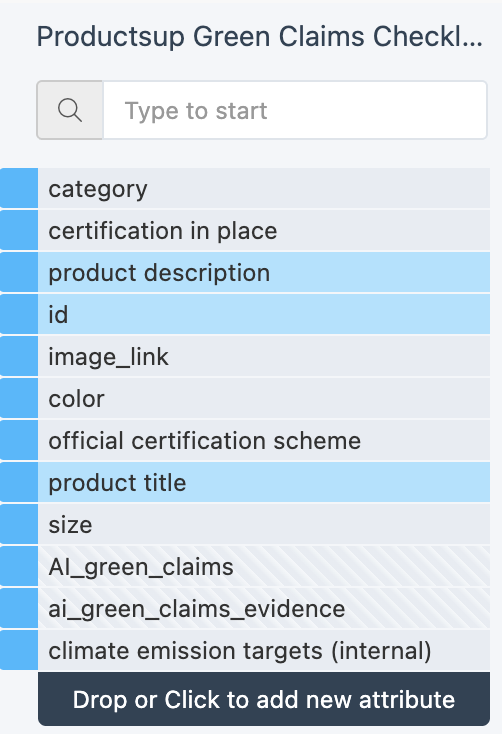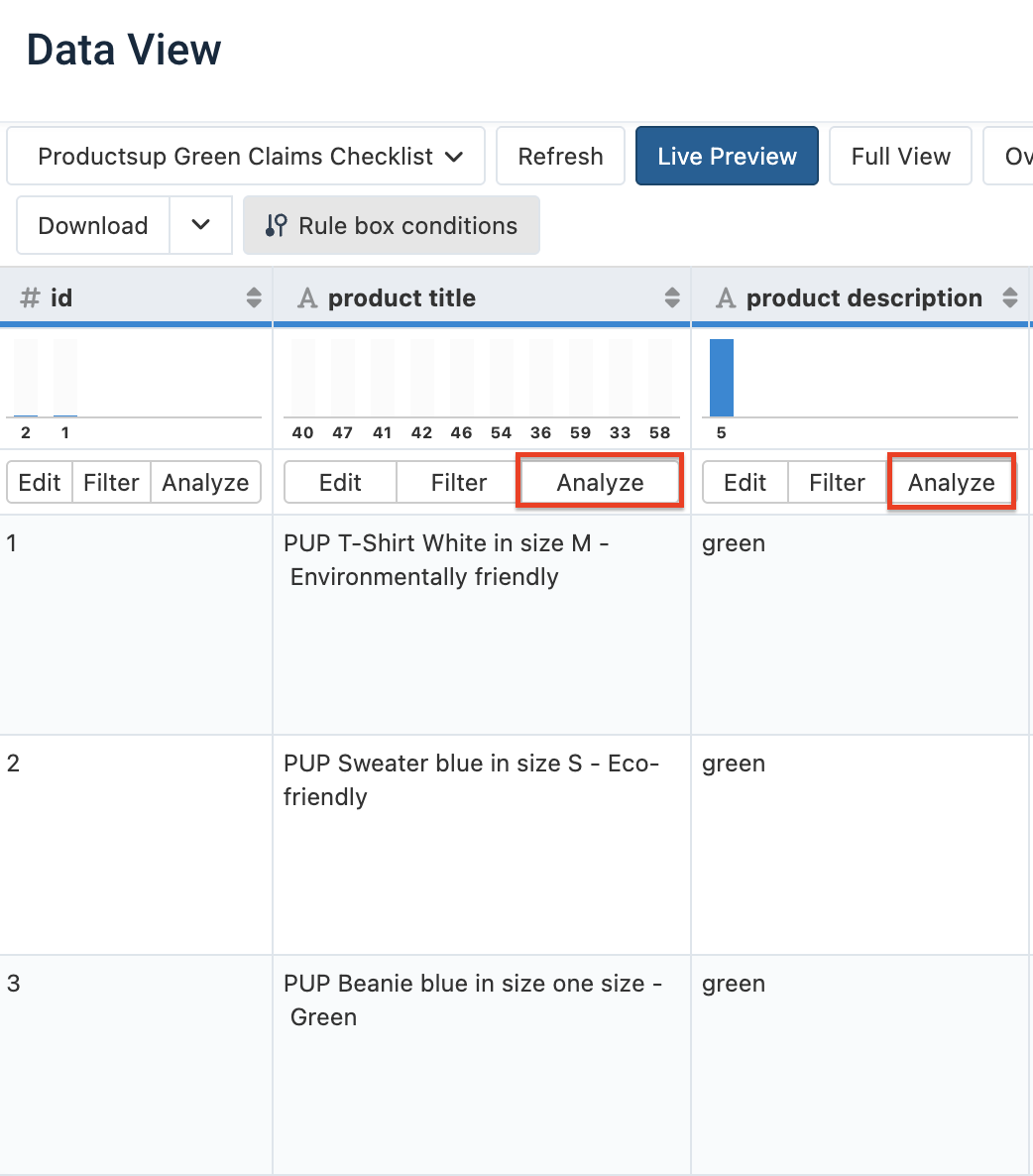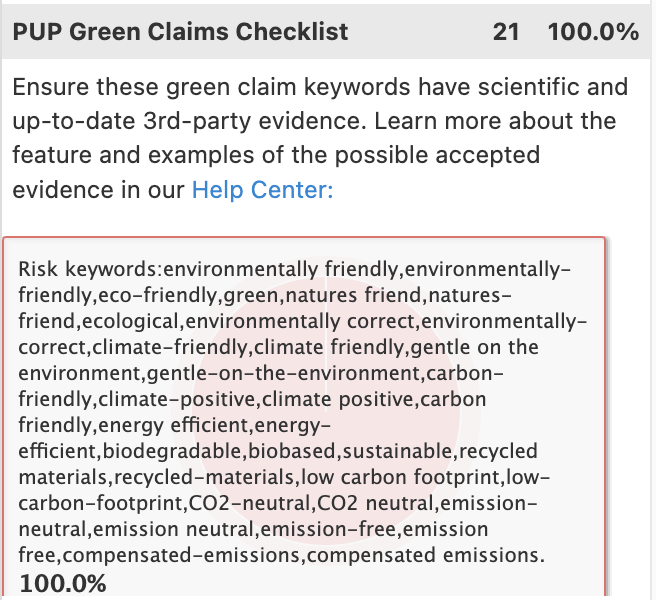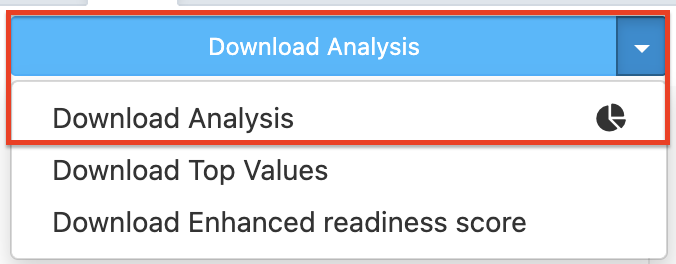Scan your data against potentially non-compliant environmental claims
Discover how Productsup can help you prepare for compliance with Green Claims Directive requirements.
In March 2024, the EU Parliament adopted the draft of the Green Claims Directive to regulate environmental claims. These regulations aim to help you prevent greenwashing and increase consumer trust.
Under the document, companies making voluntary environmental claims in the descriptions of their products need to provide consumers with the corresponding evidence. The directive outlines criteria for substantiating these claims and labels requiring an independent, accredited body to verify environmental claims before publication. The requirements will apply to all companies operating within the EU.
While the final adoption of the directive is expected in 2027, we have already built new capabilities within the Productsup platform to help you identify potentially non-compliant environmental claims in your data feed.
Important
As the directive is still in draft and won't come into effect until 2027, the claims, evidence standards, and requirements may change.
The last update of the current document is of September 2025.
Identify environmental claims in your data
We recommend scanning your data feeds for common environmental claims to prepare for the upcoming Green Claims Directive and avoid potential issues.
To simplify this process, Productsup created an on-demand feature that detects and flags potentially risky keywords.
Benefits of the Productsup Green Claims Directive feature:
Boost visibility of potentially non-compliant environmental claims within your data feed to speed up updates.
Empower you with the knowledge and supporting tools to start preparing for compliance with upcoming sustainability regulations.
Support transparency by helping you identify green claims that may require evidence.
Contact your Customer Success Manager or support@productsup.com to request the feature in your platform setup. Depending on your organization’s structure and needs, our implementation team will suggest the best solution.
Warning
The feature aims to assist with your internal review processes. Productsup provides only the supporting detection tool, which isn’t a verification or certification service.
The list of keywords and accepted evidence is indicative only and may evolve. Always consult your legal or compliance team before publishing green claims.
Productsup doesn’t assume liability for regulatory compliance. This feature is provided as is for informational purposes only and excludes liability for fines, investigations, or regulatory actions.
The ultimate responsibility for compliance remains with the customer.
Set up the Productsup Green Claims Directive feature
To set up the feature, you need to take the following steps in the site where you have your data feed that needs a check for potentially risky keywords:
Go to Exports from your site's main menu and select Add export.
Search for Productsup Green Claims Checklist, hover over it, and select Add.

On the Exports page, select the name of the added export to set it up.
Select Add Destination and choose the needed destination from the Destination dropdown. You can choose any standard flat-file destination option, such as Productsup Server or SFTP Server.
Give it a name as desired and select Save.
Go to Dataflow from the site's main menu and choose the added export from the dropdown on the left.
Map the attributes from import to export. The blue attributes are mandatory.

Go to Data View from your site's main menu and choose Productsup Green Claims Checklist from the dropdown on the left.
In the product title and product description attributes columns, select Analyze. Alternatively, select the Overview dropdown and choose Core readiness.

In the right-hand side panel, scroll down to the analyzer test PUP Green Claims Checklist to see the percentage of potentially risky words in your data feed.
Hover over the pie chart to view the keywords that require scientific evidence from approved third parties.

Select Download Analysis at the top of the Analyzer tests section and select Download Analysis from the dropdown to get the report.

Your internal team responsible for green claims can use the report for further research, checking the green claims against available and up-to-date evidence, editing the product titles and descriptions, or removing potentially risky keywords from your data feed. Then, you can either re-upload the updated data feed in Data Sources or edit the affected products in the existing feed by applying the rule boxes.
Potentially non-compliant environmental claims and examples for accepted evidence
If the platform detects potentially risky keywords in your data, ensure that you have the correct and up-to-date licenses in place.
To give you some idea of the accepted evidence, see the following examples.
Note
The examples primarily focus on key internationally recognized third-party evidence that you can use to validate a specific claim.
General claims
The following broad claims require comprehensive third-party certifications or a detailed life-cycle analysis.
Claims: environmentally friendly / environmentally-friendly, eco-friendly, green, natures friend / natures-friend, ecological, environmentally correct / environmentally-correct, sustainable.
Evidence:
ISO 14040 or 14044: A comprehensive Life Cycle Assessment (LCA) of the product or service, conducted by an independent firm.
EU Ecolabel (ISO 14024), UL ECOLOGO, or Green Seal: A certification that verifies that a product has a significantly lower environmental impact throughout its life cycle.
Nordic Swan Ecolabel: A well-respected ecolabel that certifies the environmental friendliness of a product.
Climate and carbon claims
The following claims require support with verifiable data on emissions and credible offsetting projects.
Claims: climate friendly / climate-friendly, carbon friendly / carbon-friendly, climate positive / climate-positive, low carbon footprint / low-carbon-footprint, CO2 neutral / CO2-neutral, emission-neutral / emission-neutral, emission free / emission-free, compensated emissions / compensated-emissions.
Evidence:
ISO 14067: A verified Product Carbon Footprint (PCF) study by a third party.
GHG Protocol: A corporate standard for measuring and managing greenhouse gas emissions.
Carbon Offsetting Certifications: Verification of carbon credits by a recognized standard, such as the Gold Standard or Verra. You must support claims, such as CO2-neutral, with a robust plan for emission reduction in addition to offsets. For example, PAS 2060.
PAS 2060 Specification: A globally recognized and highly detailed framework for achieving and demonstrating carbon neutrality.
CarbonNeutral certification: A certification provided by Climate Impact Partners and based on a well-defined and rigorous framework called the CarbonNeutral Protocol. This protocol is a globally recognized standard that outlines a clear process for companies to achieve and maintain carbon neutrality.
Material and resource claims
The following claims require specific third-party certifications that verify the composition and origin of materials used in products.
Claims: biodegradable, biobased, recycled materials.
Evidence:
Biodegradable: A certification from institutions, such as TÜV Austria (OK biodegradable), TÜV Rheinland, DIN CERTCO, or Biodegradable Products Institute (BPI), following standards, such as EN 13432.
Biobased: Certification from the USDA BioPreferred Program or TÜV Austria (OK biobased).
Recycled Materials: Certifications from the Global Recycled Standard (GRS) or the Recycled Claim Standard (RCS), which track and verify the content of recycled materials. You can also use RecyClass and Cradle to Cradle Certified as higher-level evidence for recycled content validation.
Energy and operational claims
The following claims are validated through third-party labels and audits that focus on a product's or company's energy performance.
Claims: energy efficient / energy-efficient.
Evidence:
EU Energy Efficiency Labels: The official EU label for appliances and products verifying their energy consumption rating.
Energy Star: An internationally recognized label for energy-efficient consumer products.